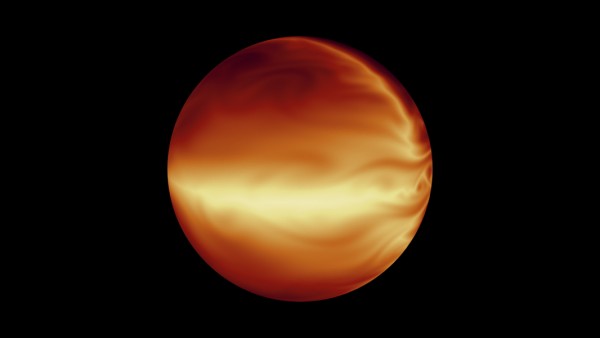By Ana Verayo, | March 29, 2016

The turbulent atmosphere of a hot, gaseous planet known as HD 80606b is shown in this simulation based on data from NASA's Spitzer Space Telescope.
Scientists are in the quest of identifying exoplanets that are orbiting distant stars in that past years where they have detected a common "hot Jupiter" type, which is a gas giant that is very much similar to the biggest planet in the solar system. In this new study, NASA's Spitzer Space Telescope just detected this bizarre hot Jupiter which has been described by astronomers as a very hot and cold, gas giant.
Like Us on Facebook
This new exoplanet is known as HD 80606b which is located some 190 light years away that also possesses a highly eccentric orbit around its host star which can be likened to a comet's behavior than other planets in the solar system.
This planet completes its orbit every 111 days and when this planet passes at the closest point to its star, the planet almost grazes its sun where it swings by so fast like a slingshot, then swings farther away from its star until it does complete U-turn on the other end of its elliptical orbit.
In our solar system, comets are more likely to follow this kind of orbit around the sun as opposed to planets which also take much longer periods to complete an orbit. Comets usually break apart and gets destroyed when they get too near the sun due to the intense heat and pressure, due to their eccentric orbits.
However, the exoplanet HD 80606b is so large that it can survive getting kissed by its own sun where astronomers believe that this gas giant planet normally experiences one of the most dramatic climate changes in the known universe.
When the exoplanet reaches its closest approach to its star, the side of the planet that is facing its sun can heat up very quickly to temperatures that can reach 2,000 degrees Fahrenheit or 1,100 degrees Celsius. When it can heat up fast, the planet can also cool down just as quickly in the same amount, in a span of one day.
According to co-author of the study, Greg Laughlin from the University of California, Santa Cruz, when the planet gets close to its star, the planet experiences a burst of intense starlight or radiation where its atmosphere quickly cooks up numerous chemical reactions and produces winds that can be stronger than any hurricane forces.
Researchers conclude that this planet is in the process of migrating inwards its solar system where its orbit can eventually turn into a more circular shape, similar to gas giants in the solar system.
This new study is published in The Astrophysical Journal Letters.
-
Use of Coronavirus Pandemic Drones Raises Privacy Concerns: Drones Spread Fear, Local Officials Say

-
Coronavirus Hampers The Delivery Of Lockheed Martin F-35 Stealth Fighters For 2020

-
Instagram Speeds Up Plans to Add Account Memorialization Feature Due to COVID-19 Deaths

-
NASA: Perseverance Plans to Bring 'Mars Rock' to Earth in 2031

-
600 Dead And 3,000 In The Hospital as Iranians Believed Drinking High-Concentrations of Alcohol Can Cure The Coronavirus

-
600 Dead And 3,000 In The Hospital as Iranians Believed Drinking High-Concentrations of Alcohol Can Cure The Coronavirus

-
COVID-19: Doctors, Nurses Use Virtual Reality to Learn New Skills in Treating Coronavirus Patients







